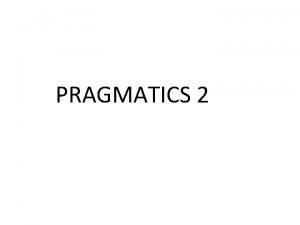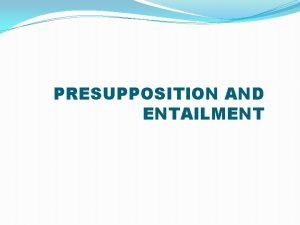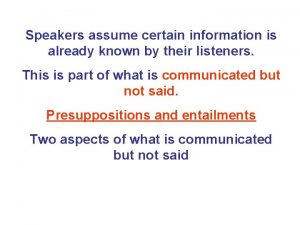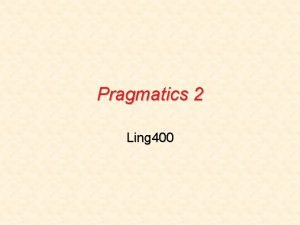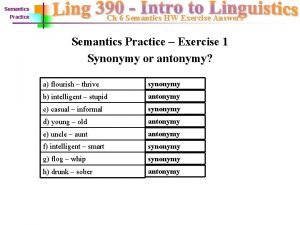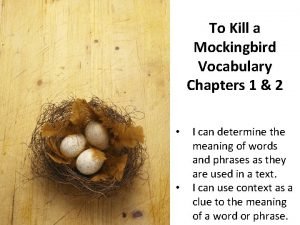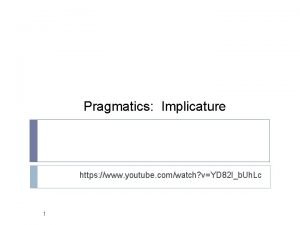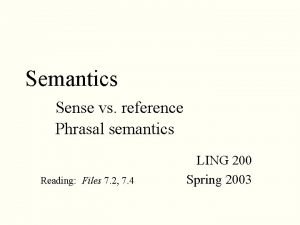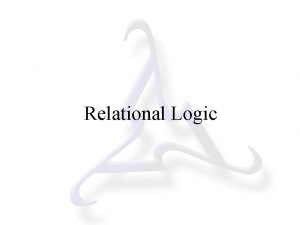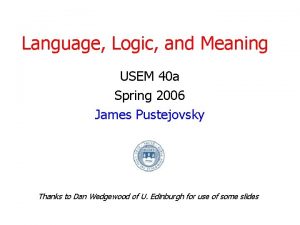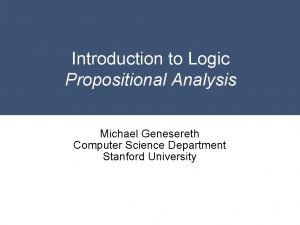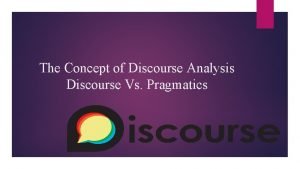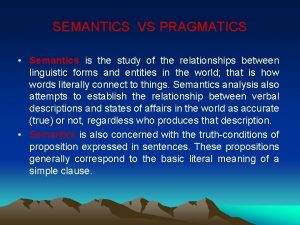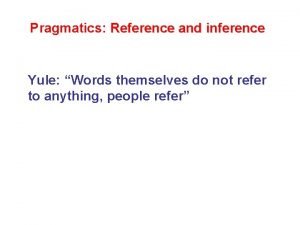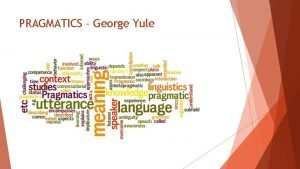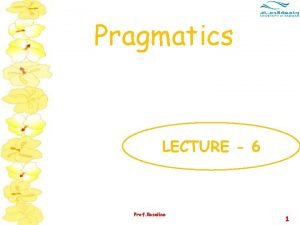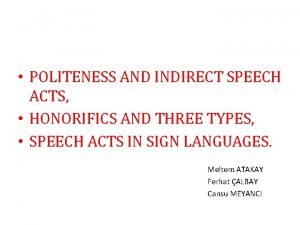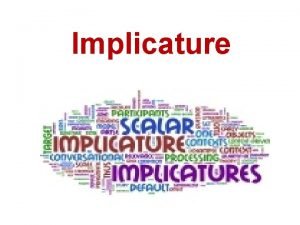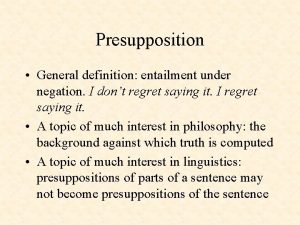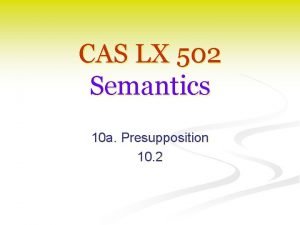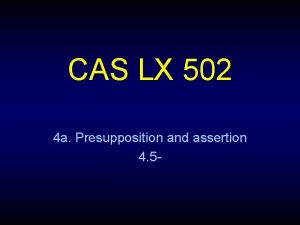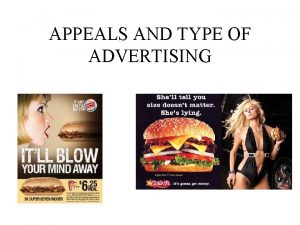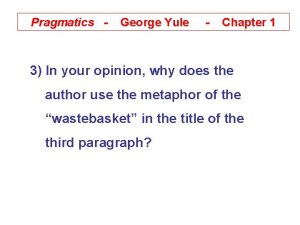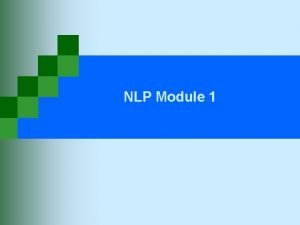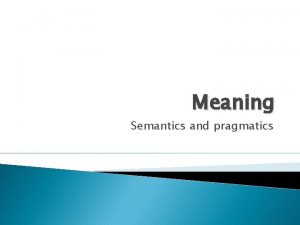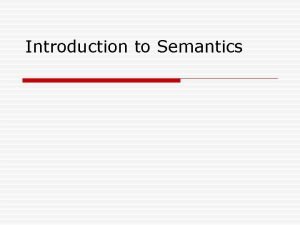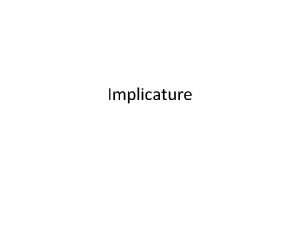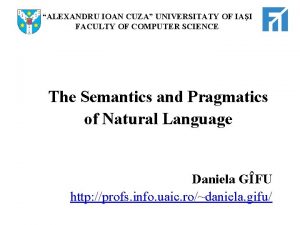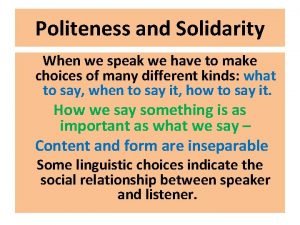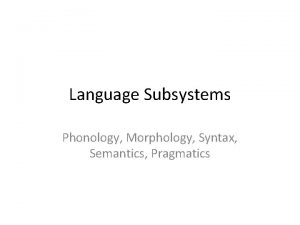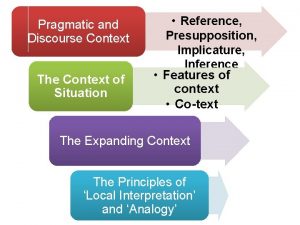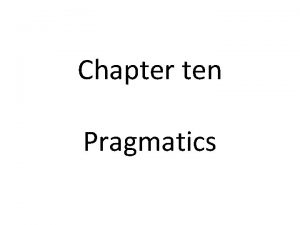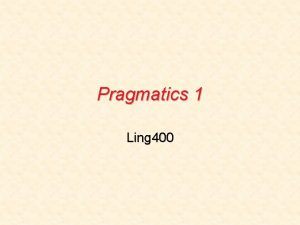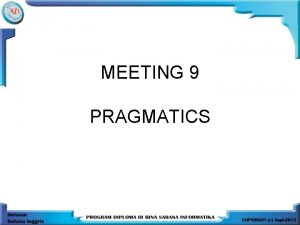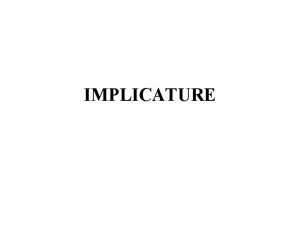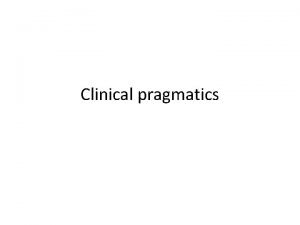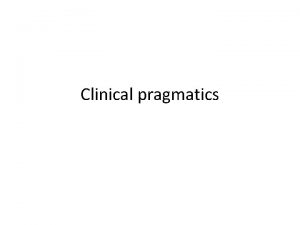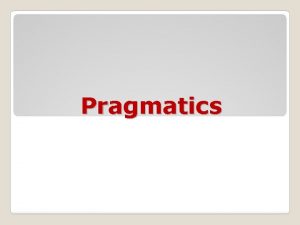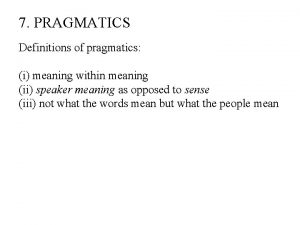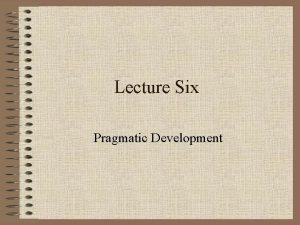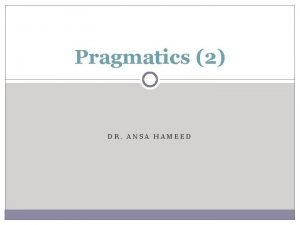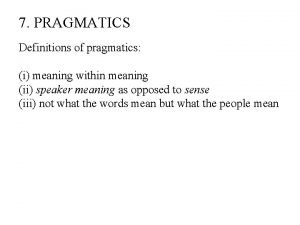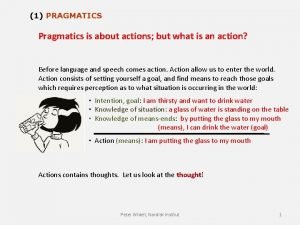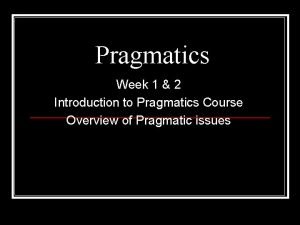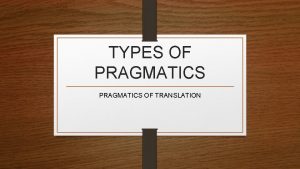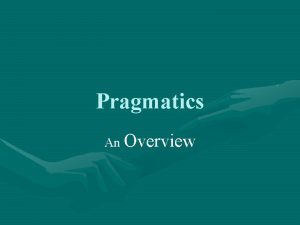PRAGMATICS 2 CH 4 PRESUPPOSITION AND ENTAILMENT Presupposition







































- Slides: 39

PRAGMATICS 2

CH. 4. PRESUPPOSITION AND ENTAILMENT Presupposition – something the speaker Presupposition assumes to be the case when making an utterance. Who has presuppositions? Speakers do; Did you buy that awful cheese? (presupposes: that cheese is awful)

Entailment – something that follows logically Entailment from what is asserted in the utterance. Who has entailments? Sentences do; She has two dogs (entails: she has two animals)

PRESUPPOSITION Her son is clever. (= p) She has a son. (= q) p>>q. (p presupposes q) Her son is clever presupposes She has a son. It is an inference the listener draws.

What happens under negation? Her son is not clever She has a son = p = q The presupposition remains constant (= true) She still has a son.

Try this: Everybody knows that she is guilty. (= she is guilty) Everybody doesn’t know that she is guilty. (= she is guilty)

TYPES OF PRESUPPOSITION Presupposition are generally potential ; they become actual when intended to be so by the speaker within a specific utterance. The types are:

Ø Existential presupposition Ø Factive presupposition Ø Lexical presupposition Ø Structural presupposition Ø Non-factive presupposition Ø Counterfactual presupposition

we commit ourselves to the existence of something what can be treated as a fact my family, the bus, her brother, the trees outside they know where he is, I’m glad that they managed

We managed to catch the ; using pig, He stopped calling one word the speaker can them (’manage’ contains ’try’. ’Stop’ contains act as if another ’having done’) meaning/word is understood

part of the structure contains information treated as already known ; the assumption that certain information is not true Why was he left alone? (=He was left alone) When did they buy the house? (=They did buy the house) He pretends that he can’t walk (=He can walk), I dreamt that I bought a horse (= I didn’t buy a horse)

Counterfactual presupposition; certain information is the opposite of true If you had helped, I would have managed in time. (=You didn’t help me)

THE PROJECTION PROBLEM Some presuppositions don’t survive when they are part of a more complex structure. Entailments are more powerful than presuppositions and can also cancel existential presuppositions. The King of France is bald. (presupposes a king) The King of France doesn’t exist.

ORDERED ENTAILMENTS Entailment ( ) is a logical concept (= ie has more to do with sentence meaning than speaker meaning): I ate three apples I ate something I ate one apple I ate two apples these are background entailments

The foreground entailments are signalled by intonation: I ate THREE apples or The ‘it-cleft’construction: It was three apples I ate

Summary: presupposition and entailment v Presuppositions are inferences about what is assumed in an utterance rather than directly asserted. v Presuppositions are closely linked to the words and grammatical structures that are actually used in the utterance and our knowledge of how to interpret them. v Presuppositions can be drawn even with little or no surrounding text.

v. All sentences have a number of – other sentences are automatically true if the original one is true. v can be drawn solely on our knowledge about the semantic relationship in a language.

CH. 5. COOPERATION AND IMPLICATURE Obvious statements – tautologies - can say a lot. - What’s your step mother like? - Well, she’s a woman and she is married to my father. They contain an implicature – additional conveyed meaning. How do we interpret implicatures?

THE COOPERATIVE PRINCIPLE (GRICE 1975) Make your contribution such as is required by the present direction of the conversation. MAXIMS Quantity 1) Make your contribution as informative as is required (for the current purpose). 2) Do not make your contribution more informative than required.

Quality Relation Try to make your contribution one that is true. 1) Do not say what you believe to be false. 2) Do not say that for which you lack adequate information. Be relevant.

Manner Be perspicuous. 1) Avoid obscurity of expression. 2) Avoid ambiguity. 3) Be brief. 4) Be orderly.

We are careful to observe these maxims and signal when we do not by using hedges The quality maxim: The quantity maxim: The relation maxim: The manner maxim: As far as I know To cut a long story short by the way, anyway I don’t know if this makes sense

Speakers communicate meaning via implicatures and listeners recognize this meaning by using inferences which assume that the speaker wants to make sense. GENERALISED CONVERSATIONAL IMPLICATURE No special knowledge is required in the context to understand the additional conveyed meaning, eg. I saw a dog chasing a cat. (Not my dog or cat)

SCALAR IMPLICATURES Choosing from a scale: some, all, most Some dogs are ugly (=not all) Sometimes, always We sometimes eat sushi (=not always)

PARTICULARIZED CONVERSATIONAL IMPLICATURES Used in specific contexts, draws on assumed knowledge: Is John back yet? The pub is still open. OR Humorous answers: Is the Pope Catholic?

CONVENTIONAL IMPLICATURES These are not based on the cooperative principle or maxims. They are associated with specific words eg. but, yet She felt sick, but went out for a walk.

Ch. 6 SPEECH ACTS AND EVENTS How to do things with words; apologizing, complaining, complimenting, promising. In a SPEECH EVENT (a set of circumstances in which people interact in some conventional way to arrive at some outcome), the circumstances give the interpretation; praise or complaint.

Speech act = an action performed by the use of a n utterance SPEECH ACT (components) Locutionary illocutionary perlocutionary

locutionary act: the basic act of utterance, a meaningful linguistic expression illocutionary act: what the utterance is intended as, what it counts as (promise, threat) perlocutionary act: the actual effect of the utterance.

It could be worked out by applying the Illocutionary Force Indicating Device (IFID) I Vp you that … Vp = performative verb I promise/threaten/insist/ that I will play the bagpipes for you.

Mostly, however, no performative verb is used. Other IFIDS are word order (question word order) stress, and intonation. Will I play… I WILL play

An alternative way of working out the illocutionary force involves felicity conditions. There are certain expected or appropriate circumstances for the performance of a speech act to be recognised as intended;

FELICITY CONDITIONS General conditions Content conditions Preparatory conditions Sincerity conditions Essential conditions the participants understand the language used eg. a promise or a warning must refer to a future event specific requirements need to be fulfilled for success, eg. promise: 1) the event will not take place without me 2) is beneficial to hearer speaker intends to carry out action the utterance commits the speaker, adds an obligation

THE PERFORMATIVE HYPOTHESIS = the assumption that underlying every utterance is a clause containing a performative verb: Pass me the salt! = I hereby order/request of you to pass me the salt. [implicit perform. ] [explicit performative] However, the two above are not equivalents, the second one being much ‘harsher’, or having a different impact. Another problem can be the difficulty of identifying performative verbs for all utterances, as in

You bloody moron! ? I hereby insult you that you are a bloody moron. We don’t know how many performative verbs there are in any language. Instead we can classify types of speech acts. There are five types of general function:

DECLARATIONS By being uttered they change the world; You’re fired! The speaker has to have a special institutional role. The speaker changes the world by using words. REPRESENTATIVES state what the speaker believes or not; statements of fact, conclusions, descriptions: I have a cat. Paris is the capital of France. The speaker makes the words fit the world.

EXPRESSIVES State what the speaker feels, express psychological states, such as pleasure, pain, joy; Sorry! Bravo! The speaker makes the words fit the world. DIRECTIVES Express what the speaker wants; orders commands, requests, suggestions: Hand me the towel! Could you pass me the butter? The speaker wants to change the world by using words.

COMMISSIVES Commit the speaker him/herself to some future action; promise, threat, refusal: I’ll buy you lunch. I’ll wring your neck! The speaker intends to change the world by using words.

SPEECH ACTS are actions performed by the use of an utterance to communicate. They can be DIRECT or INDIRECT = direct relationship between a structure and a function; Give me the salt! INDIRECT = indirect relationship between a structure and a function; Can you pass me the salt?
 Background entailment and foreground entailment
Background entailment and foreground entailment Types of presupposition
Types of presupposition Example of presupposition
Example of presupposition Implicature vs entailment
Implicature vs entailment Presupposition examples sentences
Presupposition examples sentences Entailment exercises with answers
Entailment exercises with answers To kill a mockingbird vocabulary chapter 1
To kill a mockingbird vocabulary chapter 1 Examples of scalar implicature
Examples of scalar implicature Inference vs entailment
Inference vs entailment Entailment observasi
Entailment observasi Darva conger boxing
Darva conger boxing Logical entailment
Logical entailment Linguistic meaning
Linguistic meaning Logical entailment examples
Logical entailment examples Relationship between pragmatics and discourse analysis
Relationship between pragmatics and discourse analysis Pragmatic definition in linguistics
Pragmatic definition in linguistics What is reference in pragmatics
What is reference in pragmatics Time deixis
Time deixis Difference between semantics and pragmatics
Difference between semantics and pragmatics Discourse and culture in pragmatics
Discourse and culture in pragmatics Heated attendant parking meaning
Heated attendant parking meaning Indirect speech act
Indirect speech act Implicature and explicature in pragmatics
Implicature and explicature in pragmatics Presupposition examples
Presupposition examples Pragmatic examples
Pragmatic examples Deictic expressions
Deictic expressions Presupposition examples
Presupposition examples Presupposition triggers
Presupposition triggers Examples of presupposition in advertising
Examples of presupposition in advertising The performative hypothesis
The performative hypothesis Pragmatics wastebasket
Pragmatics wastebasket Pragmatic definition in linguistics
Pragmatic definition in linguistics Componential analysis
Componential analysis Conceptual semantics
Conceptual semantics Conversational maxims
Conversational maxims Guido ipsen
Guido ipsen Pragmatic definition in linguistics
Pragmatic definition in linguistics Solidarity and politeness
Solidarity and politeness Linguistic subsystems
Linguistic subsystems Context in pragmatics
Context in pragmatics
